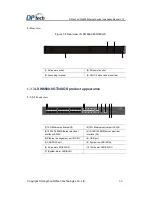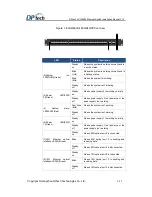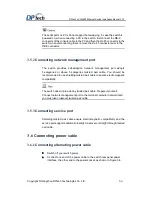
DPtech LSW6600 Ethernet Switch Installation Manual V1.3
Copyright © Hangzhou DPtech Technologies Co. Ltd.
2-2
2.2.1 Temperature/humidity requirement
The equipment room must maintain adequate temperature and humidity so
that it can ensure the device working normally and extend service life.
Long-lasting high humidity is prone to cause bad insulation and even
electricity creepage. Sometimes the mechanical performance changes of
materials, the rustiness and corrosion of some metal parts are also likely to
occur. If the relative humidity is too low, the captive screws can become loose
due to insulation washer contraction. Meanwhile, the static is likely produced
in the dry environments, jeopardizing the CMOS circuit of the product. The
higher the temperature is, the greater the damage to your device.
Long-lasting high temperature can speed up the aging of the insulation
materials, greatly lower the device reliability, and hence significantly shorten
its service life.
Table 2-1 describes the details of device temperature/humidity.
Table 2-1
Temperature/ humidity requirement for equipment room
Temperature
Relative Humidity
0
℃~
45
℃
10%
~
95%
(
non- condensation
)
2.2.2
Cleanliness
Dust is a hazard to the operating safety of your device. The dust
accumulated on the chassis can cause electrostatic adsorption, one of the
sources that cause the poor contact of connectors or metal contact points.
This not only shortens the service life of your device but also causes
communications failures. When the indoor relative humidity is low,
electrostatic adsorption is more likely to happen. The equipment room must
be free of explosion hazards and the electric and magnetic conductible dust
as well. The contents of the dust must be limited to the values shown in Table
2-2.
















































